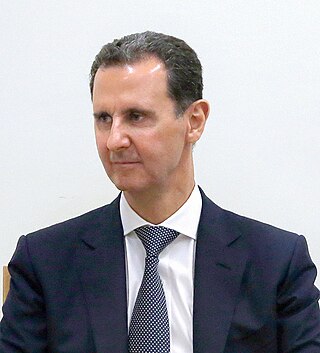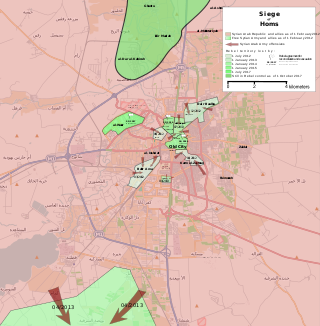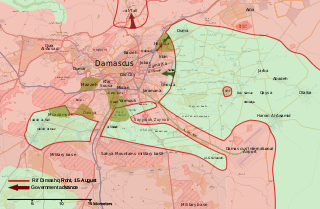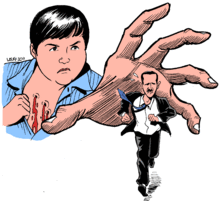
Bashar al-Assad is a Syrian politician who is the current and 19th president of Syria since 17 July 2000. In addition, he is the commander-in-chief of the Syrian Armed Forces and the secretary-general of the Central Command of the Arab Socialist Ba'ath Party, which nominally espouses a neo-Ba'athist ideology. His father and predecessor was General Hafiz al-Assad, whose presidency in 1971–2000 marked the transfiguration of Syria from a republican state into a de facto dynastic dictatorship, tightly controlled by an Alawite-dominated elite composed of the armed forces and the Mukhabarat, who are loyal to the al-Assad family.

The mass media in Syria consists primarily of television, radio, Internet, film and print. The national language of Syria is Arabic but some publications and broadcasts are also available in English and French. While television is the most popular medium in Syria, the Internet has become a widely utilized vehicle to disseminate content. Transcending all available media, the government seeks to control what Syrians see by restricting coverage from outside sources. Publications and broadcasts are monitored by members of the government. All mass media outlets are under the supervision of the Ministry of Information. Third article of the 2013 Information Ministry guidelines stipulate that purpose of all media outlets is "to enlighten public opinion" in line with the ideological doctrines "of the Arab Socialist Ba’ath Party and the policy of the state".
The following is a timeline of the Syrian Civil War from May to August 2011, including the escalation of violence in many Syrian cities.

The Free Syrian Army is a big-tent coalition of decentralized Syrian opposition armed militias in the Syrian Civil War founded on 29 July 2011 by Colonel Riad al-Asaad and six officers who defected from the Syrian Armed Forces. The officers announced that the immediate priority of the Free Syrian Army was to safeguard the lives of protestors and civilians from the deadly crackdown by Bashar al-Assad's security apparatus; with the ultimate goal of accomplishing the objectives of the Syrian revolution, namely, the end to the decades-long reign of the ruling al-Assad family. In late 2011, the FSA was the main Syrian military defectors group. Initially a formal military organization at its founding, its original command structure dissipated by 2016, and the FSA identity has since been used by various Syrian opposition groups.
Protests began in Syria as early as 26 January 2011, and erupted on 15 March 2011 with a "Day of Rage" protest generally considered to mark the start of a nationwide uprising. The Syrian government's reaction to the protests became violent on 16 March, and deadly on 18 March, when four unarmed protesters were killed in Daraa.

The siege of Homs was a military confrontation between the Syrian military and the Syrian opposition in the city of Homs, a major rebel stronghold during the Syrian Civil War. The siege lasted three years from May 2011 to May 2014, and ultimately resulted in an opposition withdrawal from the city.
The Rif Dimashq clashes were a series of unrests and armed clashes in and around Damascus, the capital of Syria, from November 2011 until a stalemate in March 2012. The violence was part of the wider early insurgency phase of the Syrian civil war. Large pro-government and anti-government protests took place in the suburbs and center of Damascus, with the situation escalating when members of the Free Syrian Army (FSA) started attacking military targets in November.
The following is a timeline of the Syrian Civil War from January to April 2012, during which time the spate of protests that began in January 2011 lasted into another calendar year. An Arab League monitoring mission ended in failure as Syrian troops and anti-government militants continued to do battle across the country and the Syrian government prevented foreign observers from touring active battlefields, including besieged opposition strongholds. A United Nations-backed ceasefire brokered by special envoy Kofi Annan met a similar fate, with unarmed UN peacekeepers' movements tightly controlled by the government and fighting.
Gilles Jacquier was a French photojournalist and reporter for France Télévisions. Jacquier worked as a special correspondent for Envoyé spécial, one of France's best known documentary programs which airs on France 2. He had a successful career, has covered major international military conflicts and won many awards during his life. He was killed on 11 January 2012 while covering the ongoing Syrian Civil War in Homs, Syria. Jacquier was the first Western journalist killed in Syria since the beginning of the Syrian Civil War.
The following is a timeline of the Syrian Civil War from May to August 2012. The majority of death tolls reported for each day comes from the Local Coordination Committees, an opposition activist group based in Syria, and the Syrian Observatory for Human Rights, another opposition group based in London.

War crimes in the Syrian civil war have been numerous and serious. A United Nations report published in August 2014 stated that "the conduct of the warring parties in the Syrian Arab Republic has caused civilians immeasurable suffering". Another UN report released in 2015 stated that the war has been "characterized by a complete lack of adherence to the norms of international law" and that "civilians have borne the brunt of the suffering inflicted by the warring parties". Various countries have prosecuted several war criminals for a limited number of atrocities committed during the Syrian civil war.

The Battle of Damascus, also known as Operation Damascus Volcano, started on 15 July 2012 during the Syrian civil war. It is unclear who started the battle. Thousands of rebels infiltrated Damascus from the surrounding countryside. Following this, according to some reports, the opposition forces launched an operation to capture the capital, while according to other reports, the military learned of the large-scale rebel operation beforehand and made a preemptive strike. Some reports even suggested the rebels launched the operation prematurely due to their plans being discovered by the security forces.
This page provides maps and a list of cities and towns during the Syrian civil war.

The Rif Dimashq offensive was a Syrian Army offensive in the Rif Dimashq Governorate during August–October 2012, as part of the Syrian Civil War.
The following is a timeline of the Syrian Civil War from September to December 2012. Information about aggregated casualty counts is found at Casualties of the Syrian Civil War.
The Battle of Yarmouk Camp was a period of fierce clashes in Yarmouk Camp during the Syrian civil war. Yarmouk is a district of Damascus that is home to the biggest community of Palestinian refugees in Syria. The fighting was between the Syrian Army and PFLP-GC on one side, and Syrian rebels on the other. The rebels included the Free Syrian Army (FSA) and a group made up of Palestinians, called Liwa al-Asifa or Storm Brigade. On 17 December, it was reported that the FSA and anti-Assad Palestinians had taken control of the camp. The FSA and Syrian Army agreed to leave Yarmouk as a neutral, demilitarized zone, but sporadic clashes continued.

The Syrian revolution, also known as the Syrian Revolution of Dignity, was the series of mass protests and uprisings – with subsequent violent reaction by the Syrian Arab Republic – lasting from March 2011 to June 2012, as part of the wider Arab Spring in the Arab world. The revolution, which demanded the end of the decades-long rule of Assad family, began as minor demonstrations during January 2011 and transformed into nation-wide mass protests in March. The uprising was marked by large-scale protests against the Ba'athist dictatorship of president Bashar al-Assad, meeting with police and military violence, massive arrests and a brutal crackdown, resulting in thousands of deaths and tens of thousands wounded.
The 2014 Syrian detainee report, also known as the Caesar Report, formally titled A Report into the credibility of certain evidence with regard to Torture and Execution of Persons Incarcerated by the current Syrian regime, is a report that claims to detail "the systematic killing of more than 11,000 detainees by the Syrian government in one region during the Syrian Civil War over a two and half year period from March 2011 to August 2013". It was released on 21 January 2014, a day before talks were due to begin at the Geneva II Conference on Syria, and was commissioned by the government of Qatar. Qatar has been a key funder of the rebels in Syria. The Syrian government questioned the report due to its ties to hostile sides against the Syrian government and pointed to how many of the photos were identified as casualties among international terrorists fighting the Syrian government or Syrian army troops or civilians massacred by them due to supporting the Syrian government.

The early insurgency phase of the Syrian civil war lasted from late July 2011 to April 2012, and was associated with the rise of armed oppositional militias across Syria and the beginning of armed rebellion against the authorities of the Syrian Arab Republic. Though armed insurrection incidents began as early as June 2011 when rebels killed 120–140 Syrian security personnel, the beginning of organized insurgency is typically marked by the formation of the Free Syrian Army (FSA) on 29 July 2011, when a group of defected officers declared the establishment of the first organized oppositional military force. Composed of defected Syrian Armed Forces personnel, the rebel army aimed to remove Bashar al-Assad and his government from power.










